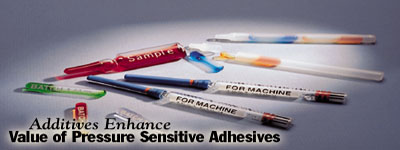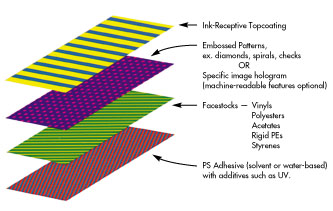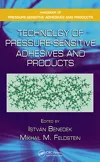Additives Enhance Value of Pressure Sensitive Adhesives

While pressure sensitive adhesives (PSAs) are renowned for their ability to make and maintain a bond, specially engineered additives can provide an even wider range of possibilities. Today, additives can offer everything from UV protection and product authentication to dissipating electrostatic discharge and magnet-receptive capabilities. Many of these additives have no impact on the bonding properties of the adhesive. Manufacturers who are ready to expand their understanding of PSA additives will find a wide range of exciting opportunities waiting for them.
In-Line Verification
Pharmaceutical labeling is held to a much higher standard than many other packaging applications. Improperly labeled medical products can lead to consumer mistakes and increase the risk of improper usage. As a result, the Food and Drug Administration requires 100% in-line label verification of all prescription and some over-the-counter medications. For applications that require this level of scrutiny, photoluminescent additives are vitally important. Although invisible to the naked eye, these additives will glow when exposed to UV light. Labelers using this method often place an optical scanner at the end of the label-production line. If the label has not been applied, or has been misapplied, the scanner will detect the absence when the UV light fails to produce a “glow.” The machine reacts by dropping the problematic container out of the production line. This helps ensure that only properly labeled containers ever make it into the marketplace.
Product Authentication
PSA additives are also commonly used as part of product-protection systems. They can help protect product manufacturers from counterfeiting efforts. In this case, the adhesive can transport, store and leave behind a diverse range of covert information.For example, one hair-care product manufacturer incorporates UV additives into its label adhesive to aid in the easy identification of counterfeit products on retail shelves. The photoluminescent additive is similar to the one used for in-line verification. However, in this case, the verification takes place in the field.
Company agents equipped with a handheld UV light visit retail stores. Using the light, they scan products on store shelves. If the product label has been tampered with, residue from the original adhesive will glow under the UV light. If the product is authentic, the company agent should only find a glowing “line” along the edge of the label, indicating that no one has attempted to remove or replace the label. If there is no glow at all, the agent can determine that a counterfeit label is being used on an imitation product.
For more secure applications, microtaggants may be used. These microscopic, rectangular “chips” look like tiny flags, and serve much the same purpose. They feature ordered, colored bands that can be verified using a magnifying glass or a microscope. The bands can be manipulated so that they fall in a specific order, allowing manufacturers to “customize” their tag.
Graphic Protection
While adhesives are often thought of when it comes time to bond an over-laminate to a graphic, additives can transform that bond into a protective coating as well, helping to limit the damaging effects of UV light. To best understand why UV light should be blocked in the first place, we need to examine the effect it can have on printed graphics.Picture a single molecule of ink. When exposed to UV light, the molecular bond that holds that ink together expands, diluting its intensity and leading to faded graphics. The darker the ink (or overall graphic), the more light it will absorb, and the quicker it will fade. Additives offer three basic protective methods, and determining the best one means understanding the end use of the graphic.
The first type of UV-protective additive works on the principle that the UV light can be absorbed and transformed into another, less harmful, form of energy. Essentially, the additive absorbs the UV light and then converts it into a different form of energy — usually heat. The heat is released gradually, warming the product, but not to the point of damaging the graphic.
Other types of UV absorbers emit the “stored” energy as a different wavelength of light. This type of inhibitor tends to hold up over time, making it ideal for long-term graphics that may be exposed to UV light.
Other UV-reactive additives absorb the UV light and then release the energy by breaking down. The more additives that break down, the less effective the UV-blocking will be. Obviously, such graphic protection is limited to short-term end uses.
The final class of absorbers is more reactive than proactive. In this case, the additive “senses” molecular changes that occur when the graphic begins to break down. The additives then react by stopping the color degradation, preventing the damage from spreading.
Colorful Creations
Additives can also offer exciting aesthetic options when combined with adhesives. In fact, many adhesives can be pigmented without compromising their inherent bonding characteristics. Pigmented adhesives have long been used with clear films to provide a cost-effective method of producing color applications. In some cases, the additive can improve the overall opacity of the product. This is especially important for labels being used in conjunction with bar codes. The ability to bar code often hinges on the level of background opacity. Specialty products, such as metallic flakes and phosphorescent additives, for example, can also provide eye-catching and glow-in-the dark effects. Recent additive advancements have extended the technology to include laminating adhesives. Smaller pigments are now used to help counter-clumping problems and ensure a more even distribution of color, which in turn leads to more consistent opacity. This approach provides for faster processing and more efficient use of press time. Stanley Manufacturing in Toronto recently used this process to apply a water-filter decal. The company used a 2-mil, white COLORtape™ product produced by FLEXcon. By using COLORtape, Stanley eliminated the need to print a flood coat and then laminate onto a transfer tape, as well as the set-up time and clean-up costs typically associated with a flood-coat station on press.

Improving Functionality
In addition to offering characteristics that are independent of the rest of the film construction, additives can also enhance existing attributes. For example, introducing a ferrous-based additive to the adhesive can augment a film that offers magnetic-receptive capabilities. Similarly, a product that provides electrostatic-discharge properties may be able to dissipate a higher level of voltage through the use of an antistatic additive in the adhesive. Electrostatic-discharge products are used to counter the static electricity that is sometimes generated when applying labeling to sensitive electronic equipment, such as circuit boards. Although the amount of static electricity may seem insignificant to the average person, even a minute electrical charge can destroy some electronic components.
Experience Provides Answers
Adhesives are versatile, but adhesive engineers who avail themselves to the ever-growing range of additive options will find themselves even better prepared to meet the expanding needs of their customers. By working with an experienced PSA manufacturer, they can take full advantage of the added value of additives.Additional information on additives for pressure sensitive adhesives and COLORtape™, RECEPTAmag™ and PHARMcal® products is available from FLEXcon’s Performance Products Business Team, 1 FLEXcon Industrial Park, Spencer, MA 01562-2642; phone 508-885-8440; fax: 508-885-8355; Web site www.FLEXcon.com.
Looking for a reprint of this article?
From high-res PDFs to custom plaques, order your copy today!





